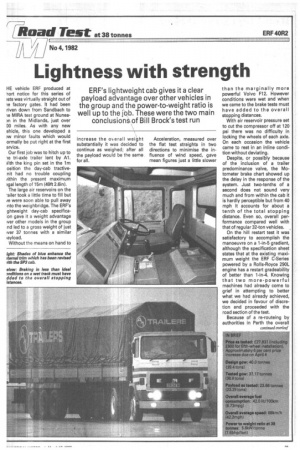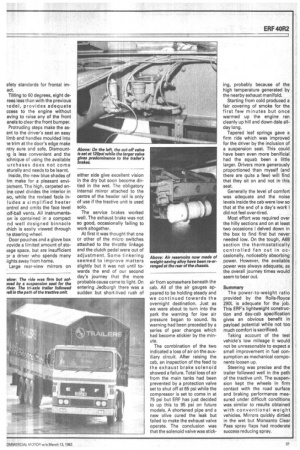Lightness with strength
Page 31

Page 32

Page 33

If you've noticed an error in this article please click here to report it so we can fix it.
ERF's lightweight cab gives it a clear payload advantage over other vehicles in the group and the power-to-weight ratio is well up to the fob. These were the two main conclusionS,of Bill Brock's test run
HE vehicle ERF produced at hort notice for this series of :sts was virtually straight out of le factory gates. It had been riven down from Sandbach to le MIRA test ground at Nunea:n in the Midlands, just over 00 miles. As with any new ehicle, this one developed a nn, minor faults which would ormally be put right at the first ervice.
Our first job was to hitch up to ie tri-axle trailer lent by Al. with the king pin set in the 1 m osition the day-cab tractivenit had no trouble coupling ,Rhin the present maximum :gal length of 15m (49ft 2.6in). The large air reservoirs on the .-ailer took a little time to fill but hre were soon able to pull away into the weighbridge. The ERF's ghtweight day-cab specificaion gave it a weight advantage iver other models in the group ,nd led to a gross weight of just iver 37 tonnes with a similar payload.
Without the means on hand to
increase the overall weight substantially it was decided to continue as weighed; after all the payload would be the same for all. Acceleration, measured over the flat test straights in two directions to minimise the influence of wind speed, gave mean figures just a little slower than the marginally more powerful Volvo F12. However conditions were wet and when we came to the brake tests must have added to the overall stopping distances.
With air reservoir pressure set to cut the compressor off at 120 psi there was no difficulty in locking the wheels of each axle. On each occasion the vehicle came to rest in an inline condition without deviating.
Despite, or possibly because of the inclusion of a trailer predominance valve, the Motometer brake chart showed up the delay in the response of the system. Just two-tenths of a second does not sound very much and from within the cab it is hardly perceptible but from 40 mph it accounts for about a tenth of the total stopping distance. Even so, overall performance compared well with that of regular 32-ton vehicles.
On the hill restart test it was satisfactory to accomplish the manoeuvre on a 1-in-5 gradient, although the specification sheet states that at the existing maximum weight the ERF C-Series powered by a Rolls-Royce 290L engine has a restart gradeability of better than 1-in-4. Knowing that two more-powerful machines had already come to grief in attempting to better what we had already achieved, we decided in favour of discretion and proceeded with the road section of the test.
Because of a re-routeing by authorities in Perth the overall continued overleaf distance covered differs slightly from other tests. During the three days, we covered 737.7 miles, returning an average fuel consumption of 42.0 lit/100km (6.73mpg) with a very fast journey time, which defies logical explanation.
We experienced a variety of weather conditions — rain on the first part of the M6 heading north, high winds between the Tay and the Forth bridges, and returning south on the M1 fog, as well •as the occasional patch of blue sky and sunshine.
The Rolls-Royce 2901_ diesel engine is a development of the less powerful 265L, which is also an inline turbocharged unit. At 38 tonnes it offers a power-toweight ratio of 5.6kW/tonne (7.6bhp/ton); as installed in the chassis it is rated at 212.6kW (285.2bhp) at a low maximum engine speed of 1,950 rpm.
Maximum torque of 1,188Nm (876th/if) occurs at 1,200 rpm. The most economical rev band is said to be between 1,200 and 1,700 rpm, which is where I tried to maintain engine speed except when hilly road conditions dictated otherwise. In top gear, however, over A-road sections the legal maximum speed equated to 1,100rpm. On level or gently undulating terrain, such as along the Al south of Scotch Corner, it was possible to drive using the overdrive top gear; but on other roads, such as the A74 into Glasgow, which has steeper gradients, constant gearchanging into direct ratio and lower was necessary.
In reality, the gearing is best suited to motorway cruising where 1,700rpm in top gear equates to the legal limit of 60mph.
Gearchanging using the Eaton Fuller range-change box which incorporates constant-mesh gears, is precise and requires only a short movement of the gearstick. Gone is the red plunger strapped below the knob. Instead, a thumb switch mounted in the head of the lever is used to control the rangechange. A 500mm (19.7in) diametel steering wheel fits in well with the confined dimensions of thE day cab, and the power steering gives a balanced feedback to thE driver, allowing precise direc. tional control.
The SP3 is the latest version oi a cab which is unique in thE commercial vehicle industry. Construction uses SMC (sheei moulded compound) grp panelz fitted on top of a welded steel frame. The result combines lightness with sufficient strength to meet both British and EEC afety standards for frontal imact.
Tilting to 60 degrees, eight derees less than with the previous iodel, provides adequate ccess to the engine without eying to raise any of the front ,anels to clear the front bumper. Protruding steps make the asent to the driver's seat an easy limb and handles moulded into ie trim at the door's edge make ntry sure and safe. Dismountig is less convenient and the .chnique of using the available urchases does not come atu rally and needs to be learnt. Inside, the new blue shades of .im make for a pleasant envionment. The high, carpeted enme cowl divides the interior in NO, while the revised facia inludes a simplified heater ontrol and omits the face level iolf-ball vents. All instrumentaion is contained in a compact nd well designed binnacle which is easily viewed through he steering wheel.
Door pouches and a glove box provide a limited amount of stowage space, but are insufficient or a driver who spends many rights away from home.
Large rear-view mirrors on either side give excellent vision in the dry but soon become dirtied in the wet. The obligatory internal mirror attached to the centre of the header rail is only of use if the tractive unit is used solo.
The service brakes worked well. The exhaust brake was not so good, occasionally failing to work altogether.
At first it was thought that one or other of the micro switches attached to the throttle linkage and the clutch pedal were out of adjustment. Some tinkering seemed to improve matters slightly but it was not until towards the end of our second day's journey that the more probable cause came to light. On entering Jedburgh there was a sudden but short-lived rush of air from somewhere beneath the cab. All of the air gauges appeared to be holding steady and we continued towards the overnight destination. Just as we were about to turn into the park the warning for low air pressure began to sound. Its warning had been preceded by a series of gear changes which had become stickier by the minute.
The combination of the two indicated a loss of air on the auxiliary circuit. After raising the cab, an inspection of the feed to the exhaust brake solenoid showed a failure. Total loss of air from the main tanks had been prevented by a protection valve set to shut off at 65 psi while the compressor is set to come in at 75 psi but ERF has just decided to up this to 95 psi on future models. A shortened pipe and a new olive cured the leak but failed to make the exhaust valve operate. The conclusion was that the solenoid valve was stick ing, probably because of the high temperature generated by the nearby exhaust manifold.
Starting from cold produced a fair covering of smoke for the first few minutes but once warmed up the engine ran cleanly up hill and down dale allday long.
Tapered leaf springs gave a firm ride which was improved for the driver by the inclusion of a suspension seat. This could have been even more benificial had the squab been a little larger. Drivers more generously proportioned than myself (and there are quite a few) will find that they sit on and not in this seat.
Generally the level of comfort was adequate and the noise levels inside the cab were low so that at the end of a day's work I did not feel over-tired.
Most effort was required over the hilly sections and on at least two occasions I delved down in the box to find first but never needed low. On the tough, A68 section the thermostatically controlled fan cut in occasionally, noticeably absorbing power. However, the available power was always adequate, as the overall journey times would seem to bear out.
Summary The power-to-weight ratio provided by the Rolls-Royce 290L is adequate for the job. This ERF's lightweight construction and day-cab specification gives an obvious benefit in payload potential while not too much comfort is sacrificed.
Taking account of the test vehicle's low mileage it would not be unreasonable to expect a small improvement in fuel consumption as mechanical components loosen up.
Steering was precise and the trailer followed well in the path of the tractive unit. The suspension kept the wheels in firm contact with the road surface and braking performance measured under difficult conditions was similar to results obtained with conventional weight vehicles. Mirrors quickly dirtied in the wet but Monsanto Clear Pass spray flaps had moderate success reducing spray.


































































